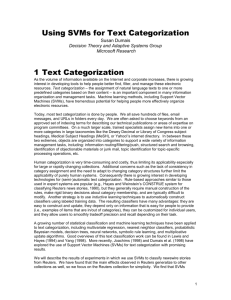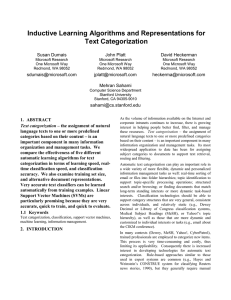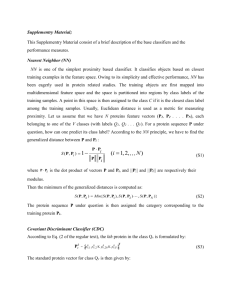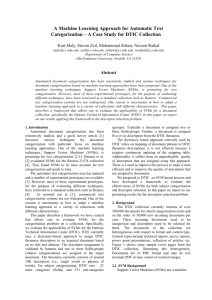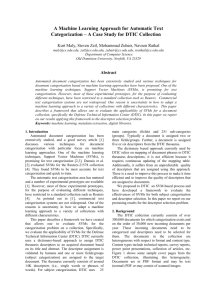1 Text Categorization
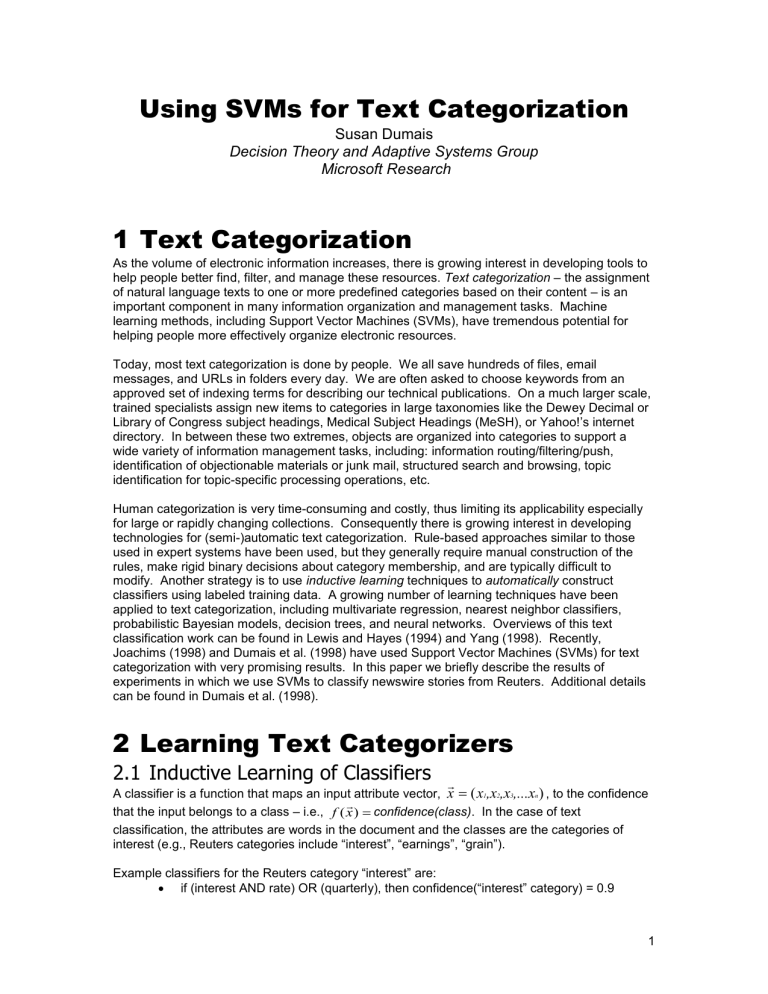
Using SVMs for Text Categorization
Susan Dumais
Decision Theory and Adaptive Systems Group
Microsoft Research
1 Text Categorization
As the volume of electronic information increases, there is growing interest in developing tools to help people better find, filter, and manage these resources. Text categorization – the assignment of natural language texts to one or more predefined categories based on their content – is an important component in many information organization and management tasks. Machine learning methods, including Support Vector Machines (SVMs), have tremendous potential for helping people more effectively organize electronic resources.
Today, most text categorization is done by people. We all save hundreds of files, email messages, and URLs in folders every day. We are often asked to choose keywords from an approved set of indexing terms for describing our technical publications. On a much larger scale, trained specialists assign new items to categories in large taxonomies like the Dewey Decimal or
Library of Congress subject headings, Medical Subject Headings (MeSH), or Yahoo!’s internet directory. In between these two extremes, objects are organized into categories to support a wide variety of information management tasks, including: information routing/filtering/push, identification of objectionable materials or junk mail, structured search and browsing, topic identification for topic-specific processing operations, etc.
Human categorization is very time-consuming and costly, thus limiting its applicability especially for large or rapidly changing collections. Consequently there is growing interest in developing technologies for (semi-)automatic text categorization. Rule-based approaches similar to those used in expert systems have been used, but they generally require manual construction of the rules, make rigid binary decisions about category membership, and are typically difficult to modify. Another strategy is to use inductive learning techniques to automatically construct classifiers using labeled training data. A growing number of learning techniques have been applied to text categorization, including multivariate regression, nearest neighbor classifiers, probabilistic Bayesian models, decision trees, and neural networks. Overviews of this text classification work can be found in Lewis and Hayes (1994) and Yang (1998). Recently,
Joachims (1998) and Dumais et al. (1998) have used Support Vector Machines (SVMs) for text categorization with very promising results. In this paper we briefly describe the results of experiments in which we use SVMs to classify newswire stories from Reuters. Additional details can be found in Dumais et al. (1998).
2 Learning Text Categorizers
2.1
Inductive Learning of Classifiers
A classifier is a function that maps an input attribute vector, that the input belongs to a class – i.e., f
( x )
x
( x
1
,x
2
,x
3
,...x
n
) , to the confidence confidence(class) . In the case of text classification, the attributes are words in the document and the classes are the categories of interest (e.g., Reuters categories include “interest”, “earnings”, “grain”).
Example classifiers for the Reuters category “interest” are:
if (interest AND rate) OR (quarterly), then confidence(“interest” category) = 0.9
1
confide nce(“interest” category) = 0.3*interest + 0.4*rate + 0.7*quarterly
The key idea behind SVMs and other inductive learning approaches is to use a training set of labeled instances to learn the classification function automatically. SVM classifiers resemble the second example above – a vector of learned feature weights. The resulting classifiers have many advantages: they are easy to construct and update, they depend only on information that is easy for people to provide (i.e., examples of items that are in/out of categories), and they allow users to smoothly tradeoff precision and recall depending on their task.
2.2
Text Representation and Feature Selection
Each document is represented as a vector of words, as is typically done in information retrieval
(Salton & McGill, 1983). For most text retrieval applications, the entries in the vector are weighted to reflect the frequency of terms in documents and the distribution of terms across the collection as a whole. For text classification simpler binary feature values (i.e., a word either occurs or does not occur in a document) are often used instead.
Text collections which contain millions of unique terms are quite common. Thus, for reasons of both efficiency and efficacy, feature selection is widely used when applying machine learning methods to text categorization. To reduce the number of features, we first remove features based on overall frequency counts, and then select a small number of features based on their fit to categories. We use the mutual information between each feature and a category to further reduce the feature space. These much smaller document descriptions are then used as input to the SVM.
2.3
Learning Support Vector Machines (SVMs)
We used simple linear SVMs because they provide good generalization accuracy and because they are fast to learn. Joachims (1998) has explored two classes of non-linear SVMs, polynomial classifiers and radial basis functions, and observed only small benefits compared to linear learn the vector of feature weights, by computing w
x where w w is the vector of learned weights, and x is the binary vector representing a new document. We also learned two paramaters of a sigmoid function to transform the output of the SVM to probabilities.
3 An Example - Reuters
3.1
Reuters-21578
The Reuters collection is a popular one for text categorization research and is publicly available at: http://www.research.att.com/~lewis/reuters21578.html. We used the 12,902 Reuters stories that have been classified into 118 categories. Following the ModApte split 75% of the stories
(9603 stories) are used to build classifiers and the remaining 25% (3299 stories) to test the accuracy of the resulting models in reproducing the manual category assignments. Stories can be assigned to more than one category.
Text files are automatically processed to produce a vector of words for each document. The number of features is reduced by eliminating words that appear in only one document and then binary feature vectors are used as input to the SVM. A separate classifier ( w ) is learned for each category. Using SMO to train the linear SVM takes an average of 0.26 CPU seconds per category (averaged over 118 categories) on a 266MHz Pentium II running Windows NT. Other learning methods are 20-50 times slower than this. New instances are classified by computing a
2
score for each document (
w
x ) and comparing the score with a learned threshold. New documents exceeding the threshold are said to belong to the category.
The learned SVM classifiers are intuitively reasonable. The weight vector for the category
“interest” includes the words prime (.70), rate (.67), interest (.63), rates (.60), and discount (.46) with large positive weights, and the words group (-.24), year (-.25), sees (-.33) world (-.35), and dlrs (-.71) with large negative weights.
3.2
Classification Accuracy
Classification accuracy is measured using the average of precision and recall (the so-called breakeven point). Precision is the proportion of items placed in the category that are really in the category, and Recall is the proportion of items in the category that are actually placed in the category. Table 1 summarizes micro-averaged breakeven performance for 5 different learning algorithms explored by Dumais et al. (1998) for the 10 most frequent categories as well as the overall score for all 118 categories. earn acq money-fx grain crude trade interest ship wheat corn
Findsim
92.9%
64.7%
46.7%
67.5%
70.1%
65.1%
63.4%
49.2%
68.9%
48.2%
NBayes
95.9%
87.8%
56.6%
78.8%
79.5%
63.9%
64.9%
85.4%
69.7%
65.3%
BayesNets Trees
95.8% 97.8%
88.3%
58.8%
89.7%
66.2%
81.4%
79.6%
85.0%
85.0%
69.0%
71.3%
84.4%
82.7%
76.4%
72.5%
67.1%
74.2%
92.5%
91.8%
LinearSVM
98.2%
92.7%
73.9%
94.2%
88.3%
73.5%
75.8%
78.0%
89.7%
91.1%
Avg Top 10
Avg All Cat
64.6%
61.7%
81.5%
75.2%
85.0%
80.0%
88.4%
N/A
91.3%
85.5%
Linear SVMs were the most accurate method, averaging 91.3% for the 10 most frequent categories and 85.5% over all 118 categories. These results are consistent with Joachims (1998) results in spite of substantial differences in text pre-preprocessing, term weighting, and parameter selection, suggesting the SVM approach is quite robust and generally applicable for text
0.4
0.3
0.2
0.1
0
1
0.9
0.8
0.7
0.6
0.5
0
LSVM
Decision Tree
Naïve Bayes
Find Similar
0.2
0.4
0.6
0.8
1 categorization problems.
Figure 1 shows a representative ROC curve for the category “grain”. This curve is generated by varying the decision threshold to produce higher precision or higher recall, depending on the task.
The advantages of the SVM can be seen over the entire recall-precision space.
3
4 Summary
Very accurate text classifiers can be learned automatically from training examples using simple linear SVMs. The SMO method for learning linear SVMs is quite efficient even for large text classification problems. SVMs also appear to be robust to many details of document representation. Our text representations differ in many ways from those used by Joachims
(1998) – e.g., binary vs. weighted feature values, 300 terms vs. all terms, linear vs. non-linear models – yet overall classification accuracy is quite similar. Inductive learning methods offer great potential to support flexible, dynamic, and personalized information access and management in a wide variety of tasks.
5 References
Dumais, S. T., Platt, J., Heckerman, D., and Sahami, M. Inductive learning algorithms and representations for text categorization. Submitted for publication , 1998. http://research.microsoft.com/~sdumais/cikm98.doc
Joachims, T. Text categorization with support vector machines: Learning with many relevant features. European Conference on Machine Learning (ECML), 1998. http://www-ai.cs.unidortmund.de/PERSONAL/joachims.html/Joachims_97b.ps.gz
Lewis, D.D. and Hayes (1994). Special issue of ACM:Transactions on Information Systems on text categorization, 12(1), July 1994.
Platt, J. Fast training of SVMs using sequential minimal optimization. In B. Schoelkpf, C. Burges,
A. Smola (Eds.), Advances in Kernel Methods --- Support Vector Machine Learning . MIT Press, in press, 1998.
Salton, G. and McGill, M. Introduction to Modern Information Retrieval . McGraw Hill, 1983.
Yang (1998). An evaluation of statistical approaches to text categorization . Journal of
Information Retrieval.
Submitted, 1998.
4
Author Information:
Susan T. Dumais is a senior researcher in the Decision Theory and Adaptive Systems Group at
Microsoft Research. Her research interests include algorithms and interfaces for improved information retrieval and classification, human-computer interaction, combining search and navigation, user modeling, individual differences, collaborative filtering, and organizational impacts of new technology. She received a B.A. in Mathematics and Psychology from Bates
College, and a Ph.D. in Cognitive Psychology from Indiana University. She is a member of ACM,
ASIS, the Human Factors and Ergonomic Society, and the Psychonomic Society, and serves on the editorial boards of Information Retrieval, Human Computer Interaction (HCI), and the New
Review of Hypermedia and Multimedia (NRMH). Contact her at: Microsoft Research, One
Microsoft Way, Redmond, WA 98052, sdumais@microsoft.com
, http://research.microsoft.com/~sdumais.
Author Picture (jpeg):
5

